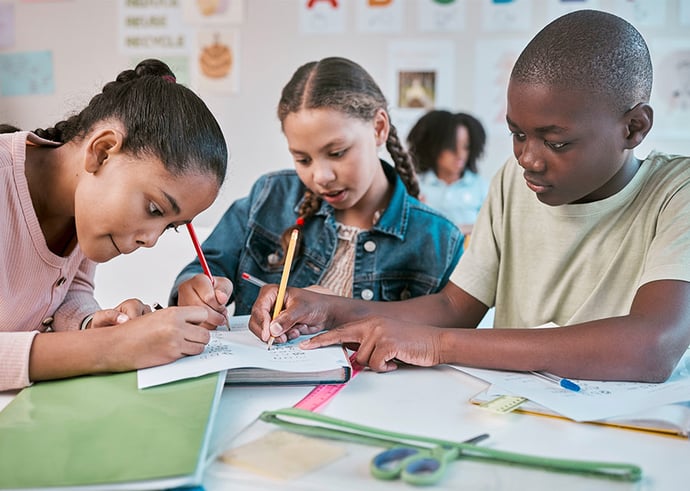
The idea of using learning tools to think isn’t new, but what storyline pedagogy provides students is a creative place to practice their critical thinking skills. Students who repeatedly work together as a team, speak in front of their class, and provide feedback to their peers – get better at it. Engaging in NGSS storylines in the classroom gives students a chance to take the lead in their own learning process, while practicing hands-on investigation skills and thinking moves in the process.
What are Thinking Moves?
Thinking moves are learning strategies that help students think deeper. Actively using thinking moves in the classroom helps students to develop a more complete and complex understanding of how phenomena work and interact across disciplines. Harvard University researchers David Perkins, Shari Tishman, and Patricia Palmer developed a list of six thinking moves that help students engage in deeper learning. In their book Making Thinking Visible, Ron Ritchhart, Mark Church, and Karin Morrison added two more thinking moves to the list.
NGSS storylines promote deeper learning, which occurs at the intersection of mastery, identity, and creativity – through the use of thinking moves. The term ‘deeper learning’ also comes from the book Making Thinking Visible. When we create a culture of thinking in the classroom and give students the time and space to wonder, experiment, collaborate, and reason – we provide a place where deeper learning can occur.
Thinking Moves that Engage Deeper Learning
- Observing closely and describing what’s there
- Building explanations and interpretations
- Reasoning with evidence
- Making connections
- Considering different viewpoints and perspectives
- Capturing the heart and forming conclusions
- Wondering and asking questions
- Uncovering complexity and going below the surface of things
It can be helpful to post a list of thinking moves in the classroom, as a daily reminder of the intellectual rigor we are expecting from our students. Students should be engaging in each one of the thinking moves daily. As the students actively engage in the thinking moves, it is the teacher’s role to model curiosity, ask the students to make their thinking visible, and provide feedback that students can use to improve their thinking immediately.
If students aren’t engaged in thinking moves themselves, the knowledge they are building may include significant gaps in their understanding. For example, if students observe an experiment and describe it, but they don’t use that information to make their own conclusions, listen to other perspectives, and then bring those complex layers of information together to form a new understanding of the phenomenon – they are not learning how to think deeper.
Storyline pedagogy encourages the complex process of wondering, investigating, uncovering, reasoning, sharing, and making conclusions. In doing so, students are building an understanding of how thinking and reasoning, investigating, and collaborating help us uncover the complexities of the world around us. Modeling creative thinking and questioning is essential, especially at the start. If we want students to ask better questions, think deeper, and take intellectual risks – we have to show them how to do it and prove that it is rewarded.
How to Integrate Thinking Moves into Storyline Pedagogy
The first step to integrating thinking moves and storyline pedagogy is creating a culture of thinking. This requires students and teachers to collaborate in a new way of thinking and learning. This is more rigorous, but it’s fun, and it connects immediately and personally with students’ curiosity about the world around them. Creating a safe space where everyone’s ideas are valued is key.
As the use of thinking moves becomes routine, teachers must continue to actively work to reinforce and protect the culture of thinking, promoting a classroom environment where creativity is promoted and respected by all. In this stage, the teacher truly becomes a thought-partner, helping students engage in thinking moves rather than sticking closely to routines and frameworks. As they get better at storylines, students can take on even more responsibility for selecting questions they want to answer and problems they want to solve, linking classroom learning to real-world phenomena, and thinking deeply about the anchor phenomena. As thinking moves become routine, classroom discussions and storylines become richer and more complex.
Utilizing feedback methods like formative assessments that encourage deeper thinking, questioning, and risk-taking is key to encouraging the use of thinking moves. Students must be rewarded for investigating, personalizing their experience with the phenomena, collaborating with their peers, and pushing boundaries. Engaging in group discussions that encourage students to share with the group and provide feedback also gives them the opportunity to learn from observing different viewpoints. As some pairs begin to get more creative and think deeper, all students can learn from the results of their thinking moves.






